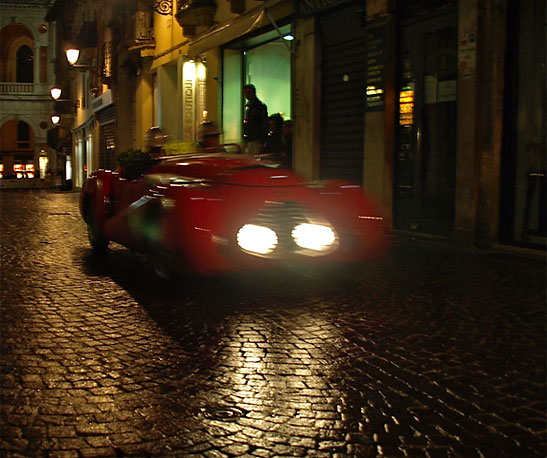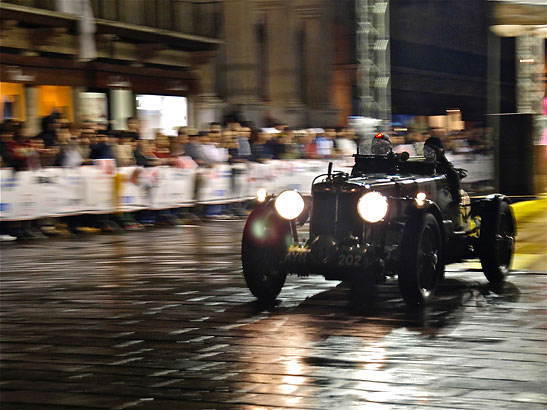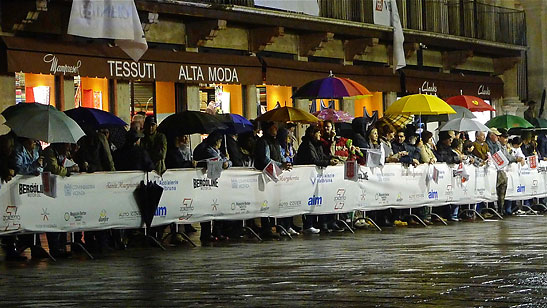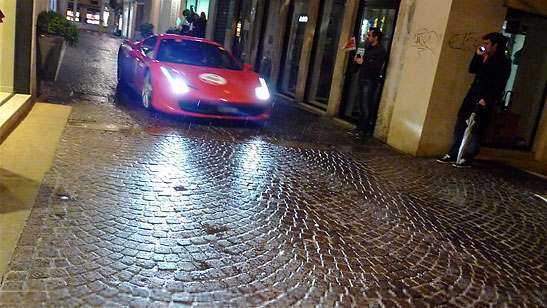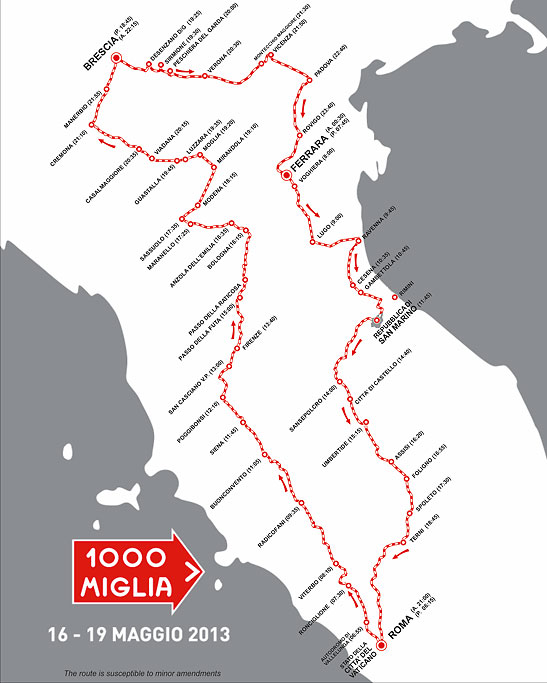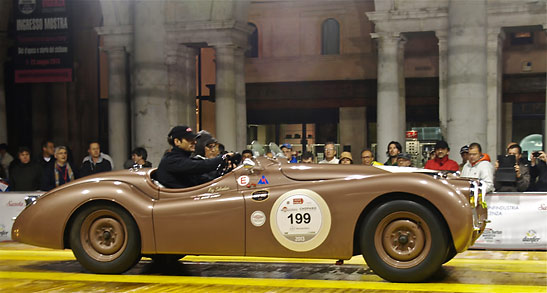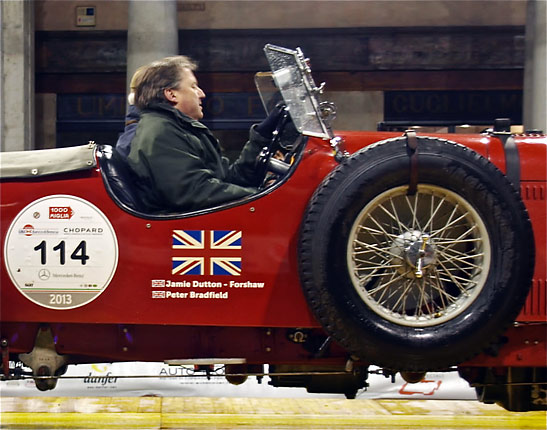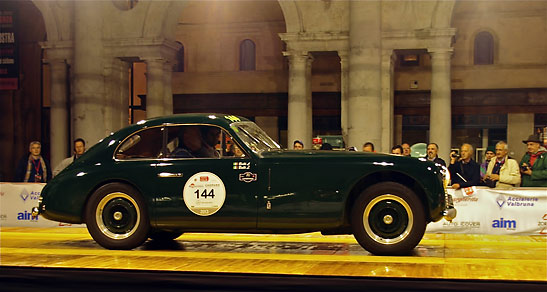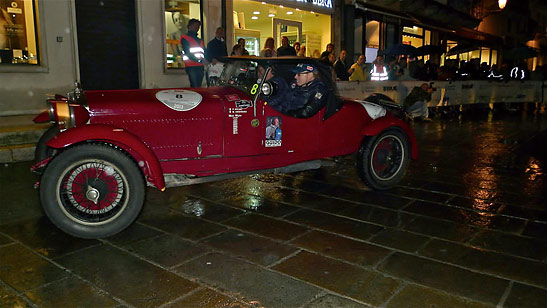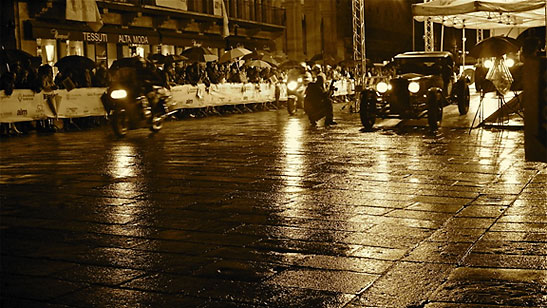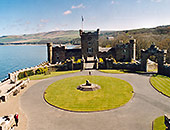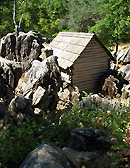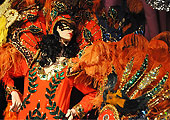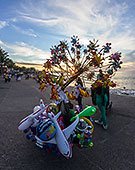 |
 |
|
 |

|
Traveling Boy Bloggers on the
Move:
Mother Nature was not on her best behavior – or she just wanted to make the endurance that much tougher on "horse and rider" – as she pelted the "City of Palladio" earlier in the day with heavy rains, making the centuries-old stone below precarious and the road-weary pilots above tentative.
Under cover of umbrellas, thousands of Vicentini lined the route cheering loudly as each team honked as they sped by. Collectively, the fans felt goose bumps, the kind one feels when one has just witnessed history on four wheels roll right on by.
If pasta, pomodori and Prosecco help define Italy's dinner table, then motor racing, of ANY kind, helps define the Bel Paese's unquenchable thirst for competition. And no single race stirred that passion in her citizenry more than the Mille Miglia did. In the words of one of racing world's most famous personalities, the late Enzo Ferrari, the Mille Miglia was, la corsa più bella del mondo (the most beautiful race in the world).
The 1,000-mi. road race, rounded up from the actual distance of 992 mi., was a pedal-to-the-metal, white-knuckled, no-holds-barred road race – a la the chariot race scene from Ben Hur – that ran on public roads lined by millions of spectators from Brescia up north to Rome down south and back.
Today, the race is an annual commemorative rally dubbed the Mille Miglia Storica. It's still run on public roads during May and follows pretty much the same route as that of the classic; but, where the road race focused on neck-breaking, daredevil speeds over one non-stop, frenetic day, the Storica focuses on rally skills and safety over a less stressful three-day period.
The original "double M" thundered through six regions and one tiny republic, avoiding man and beast most of the time, from 1927 until 1957. It was legendary British racecar driver Sir Sterling Moss who set the record in the 1955 edition, covering the circuit in just 10 hrs. 7 min. 48 sec. Unfortunately, Moss' record-setting pace was one of the major reasons why the road-race format was eventually discontinued.
Many drivers were hell-bent on breaking Moss' record, only to fail. Marquis Alfonso de Portago, racing against the clock, died during the 1957 event when the Ferrari he was piloting blew a tire and flipped end-over-end into the crowd killing his co-pilot and nine spectators just a handful of miles shy of a top-four finish.
After that fateful '57 race, the Mille Miglia came to a screeching halt and ended up on blocks for nearly 25 years until the format was retooled. With new life in the tank, the event returned to the open road as the more sedate Mille Miglia Storica.
The iconic Sig. Ferrari got it absolutely correct back then in his description of the Mille Miglia. Even in today's reformatted version, it still remains the most beautiful race in the world. Related Articles: |
|
Feedback for Destination Bosnia: Inside Sarajevo's Tunnel of Hope Spent time in Sarajevo in the fall of 1973…beer was excellent! --- David * * * * Hi Tom, I must say, you're photographs are always amazing. They are top notch. You bring so much class to Traveling Boy. It's photographs like yours that make me want to go out and do my own traveling. Please don't get tired of sending us your amazing adventures. It's such a delight for the soul. --- Raoul, Whittier, CA * * * * Hi Tom: --- David * * * * Hey Tom – Wow! Love those photos – they are so super that they make me A) Want to start eating NOW. B) Go there myself. C) See all that pristine beauty that looks so restful and peaceful. Great story, superb pix!!! Bravo!! --- John, Los Angeles, CA * * * * Feedback for Destination Southwestern France: Saint-Émilion Good job, Tom, and timely info. St. Émilion is in the list of places Jim Hayes and I will visit in September 2014. If we get the chance, we will exploit your experience to enhance the trip! --- Bobby Harper, Dameron, MD * * * * Feedback for Vicenza Walks – Monte Berico I lived in Vicenza for 4 years in the U.S. ARMY from 1963 to 1967. A wonderful place to explore. Palladio’s works are amazing. Have been back twice since and find new places to visit. My favorite is MONTE BERICO where I have some wonderful photos of my family. --- Dr. Albert Pizzi, Hanover, MA * * * * I liked the new TB particularly the Vicenza article that took me back as a youth when we lived in Naples and travelled up there for a baseball tourney (U.S. Military Bases dependent schools played each other.) Took me back to the plaza. --- Bill Feedback for A Canterbury Trail (Sutri) Very interesting note. I have wedroned which route the early pre-Christian and Christian pilgrims travelled to Rome from England. Is it still possible to travel the Francigena trail? --- Pawel You can find out more info on walking tours of Via Francigena at this site: http://www.compagniadeicammini.it/en/. Thanks for stopping by and commenting.. Tom * * * * Good article, enjoyed reading it. Saved your recommended sights for future use. --- Dardenne Prairie, MO * * * * You're going to be great at this Tom. Congrats. --- Donna Vissa -Montreal
|
|
| ||||
|
| ||||
This site is designed and maintained by WYNK Marketing. Send all technical issues to: support@wynkmarketing.com

|






